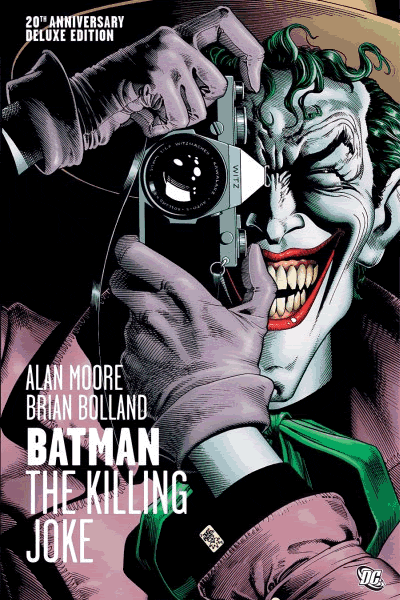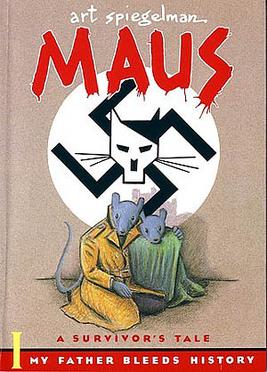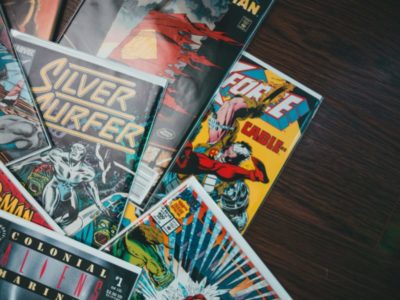Graphic novels grab the attention of the reader with a grip unlike any other. Within the pages of comics, stories unfold before our eyes through endearing characters and amazing artwork. The imagery within graphic novels elevates the authors narrative to unimaginable levels comparable to movies. Certain novels go beyond their calling to further indulge the reader in a world apart from our own. These critically acclaimed successes brought comics out of the trope of nerdy stereotypes and into the light of mass readership.
Read on for the greatest graphic novels of our generation and the past.
1. The Walking Dead by Robert Kirkman

Prior to evolving into a multi-million-dollar AMC television series, this undead epic arose from the pages of a graphic novel. Robert Kirkman wrote the series with Tony Moore, who’s artwork resides in other series like Fear Agent and The Exterminators. This zombie horror storyline separates itself from other comics through its focus on themes of primal instinct, betrayal and death.
Are you really a Walking Dead fanatic if you haven’t read the thousands upon thousands of pages of graphic novel alongside the televised show? The show splattered onto the screen, bringing the apocalyptic wastelands into our living rooms. We all like to think that at the end of time we would keep our cool to ensure survival, yet this comic makes you second guess those morals.
2. Scott Pilgrim vs. The World by Bryan Lee O’Malley

In a world where pop culture reigns supreme, video games consume a solid amount of our downtime. Being a nerd isn’t so bad after all— you end up getting a graphic novel that caters to that audience perfectly. While the novel came out in 2004, it perfectly captures the essence of geekdom. Many fans of the series first witnessed the misadventures of Scott through the theatrical documentary of Michael Cera’s life— I mean, the Scott Pilgrim film (whoops).
“Bryan Lee O’Malley has a very unique style that uses bold lines and cartoonish designs. The story he created is almost like a modern-day love story mixed with the video game concept of fighting evil bosses for the princess to put it short,” St. John’s University sophomore Jake Van Tassel said.
The novel shows the mind of a nerd so enveloped in his ways that the idea of confronting your girlfriend’s ex’s looms over you like a level 100 boss staring down a protagonist only three levels into the game. The whimsical humor paired with the 2000s style art to create a concoction that resembles an energy drink most nerds drink regularly.
3. Sin City by Frank Miller

In 1991, the visionary Frank Miller penned the Sin City chronicles. These noir inspired tales take place within the gritty streets of Basin City. Interconnected storylines of gang violence featuring recurring characters cater to fans of dark, brutal mafia style narratives.
Miller goes above and beyond (as per usual) to deliver an award-winning collection of comics. The slums of Sin City leave you feeling like you need to take a shower after reading. The graphic novel lent itself to two feature length films that Miller co-directed himself. The series followed on the heels of one of the most groundbreaking novels of all time, The Dark Knight Returns.
4. Flashpoint by Geoff Johns

Arguably the penultimate storyline for superhero, The Flash. Whether you’re a surreal fan of the speedster or simply hoping to enjoy a thrilling comic, this storyline sets the bar. Barry Allen, the super speed powered hero “Flash,” ultimately ends up in an alternative reality unlike his own. Bruce Wayne, whose parents were murdered in an alley, takes the place of the grave in exchange for his parents, who embody the new Batman and Joker. An abundance of characters undergo similar role reversals, all while Barry remains the only one aware of this mayhem. Upon the quest to set things right he discovers that his own actions set this timeline in motion.
“It really highlights just how much power The Flash holds beyond just speed. One simple change in saving his mom almost caused the entire world to end in an alternate timeline. It wasn’t just about being fast to stop a villain, but to undo a choice that was ultimately selfish even if understandable,” St. John’s University junior Patrick Timoney said.
By rescuing his mother Barry, triggers a cataclysmic chain of events that shatter the existing reality. For those familiar with It’s a Wonderful Life, the message shares similar themes. Our decisions leaves a domino effect on not just our own lives but the lives of others. Rumors continue to circulate the internet regarding this narrative influencing the next Flash film. So if you want to wait for the film, you can. Just know that the book is always better.
5. Sandman by Neil Gaiman

Many of you may recognize Gaiman for his work on American Gods or his book on Norse mythology. However, prior to this extensive literature on mythology, enter Sandman. This graphic novel surprised many DC fans upon release due to the typical niche of superheroes clashing in epic proportions.
Comics took that turn in the late 80s, emphasizing that illustrated stories belong beyond entertaining children. Gaiman took the character Morpheus, along with the remaining entities, to deliver a mythological blend of horror and fantasy where the metaphysical found shape through Gaiman’s signature personification.
Not only does Sandman stand a monumental accomplishment for Gaiman, but the series stands a testament to the belief that comics can exceed face value “bangs and pows.” The storyline most recently received the audiobook treatment with James McAvoy lending his voice to Morpheus.
6. Batman: The Killing Joke by Alan Moore

The quintessential Joker origin story rests in the pages of this 1988 “one shot.” Prior to this psychological examination, the Joker existed merely to counter Batman’s honor and to terrorize the citizens of Gotham. In this story, the clown prince of crime arguably comes off a sympathetic figure opposed to the hateful psychopath.
The story centers around Joker’s attempt to drive Commissioner Jim Gordon insane. Throughout the pages, we witness the downfall of a failed comedian who loses his pregnant wife all within a short span of time. Through such tragedy we begin to understand that “one bad day” can lead anyone astray. The story invites the reader to question their own course of action if they were in the Joker’s shoes.
The short narrative inspired Todd Philips’ film, delivering more than just significant lore. The story compares and contrasts two characters who you originally believe could not be farther apart. Yet in that iconic conclusion share a laugh in the pouring rain, leaving you to question your preexisting notions.
7. V for Vendetta by Alan Moore

“People shouldn’t be afraid of their government. Governments should be afraid of their people.” The words of V, the titular anarchist revolutionary of the novel, resonate the overall attitude that the story portrays. The dystopian United Kingdom sketched onto the pages asks the question of our future. V, who dons a Guy Fawkes mask, guides the initially innocent Evey Hammond down his path of revolution.
Together, the two dismantle the system, seeking revenge on those that tortured them. The novel left in its wake the anarchist symbolism of the Guy Fawkes mask, a film and the ideals that laced the literature.
8. The Dark Knight Returns by Frank Miller

This 1986 graphic novel by master writer/artist Frank Miller reinvents Batman for a more mature audience. Prior to this reinvention, people still scoffed at the idea of a man in a bat costume going around fighting villains named “polka dot man.” Miller takes the character of Batman, rolling the dice to see how open readers were to such a shift. Let’s just say that it paid off. The aging Bruce Wayne comes out of retirement to clean the streets of a crime ridden Gotham once again.
“The significance behind Frank Miller’s TDKR was that it was a turning point for not only the character of Batman, but for comics in general. It was the first time a character whose history has been surrounded by campy, kid-friendly themes was brought to a more grounded and serious level. It showed what might be if a hero like Batman were to actually exist and what the repercussions of being that hero would be like,” College of Staten Island junior Kyle Feliciano said. “What tolls might they take mentally? Physically? Reading it for the first time was like opening a doorway to an entirely new version of Batman that felt fresh and fulfilling. It also expanded the boundaries on who can read and enjoy comics. Adults now had a comic of their own that they can take more seriously. The term “graphic novel” was solidified and TDKR plays a major part in that history. As for the Batman character, it laid the groundwork for the dark, brooding, and gothic adaptations of Batman that we know today.”
The story tackles the dynamic between an older Joker and Batman, which causes the reader to question whether one can exist without the other. Simultaneously, Miller juggles moral ambiguity and feminism through the introduction of Carrie Kelley as a teenage robin. This trailblazing comic not only reinvented Batman— but it also became one of the first comics to truly take the darker route in reimagining what graphic novels are capable of.
9. Watchmen by Alan Moore

At this point Alan Moore needs a list all his own, but you can’t create a list of the best graphic novels without mentioning Watchmen. The 1987 comic continues to rank among the absolute best in novels to this very day. The story follows a group of heroes who exist in an alternate history where the United States grows ever closer to an all-out war with the Soviet Union.
The concerns of morality plague the existing heroes that often embody a squeaky-clean persona. Like any other human, these heroes have faults. The costumed vigilantes contemplate the line between good and evil, the composition that makes up humanity, and the hopelessness of the future.
Heroes may embody the imagery of a deity, yet behind the cowl, there lies a human dealing with human problems. This defining novel spawned a slew of darker thematic comics along with accumulating awards for its critical success in exploring such philosophical ideologies.
10. The Complete Maus by Art Spiegelman

This novel broke the stereotype that comics exist purely for the entertainment of “nerds.” The harrowing tale of Spiegelman’s parents navigating Hitler’s Europe lays out the atrocities of war through this recounting. The persecuted Jewish people are replaced by mice who must survive against the ever-pursuing cats that take on the role of the Nazis. The atrocity of war bleeds through the art provoking sensations of grief, relief and survival.
This masterpiece takes a personal story seen through the eyes of the descendant of survivors and reveals the eternal wounds to the world. Having been originally released in 1980, it stands to reason why this piece was the first graphic novel to ever receive the Pulitzer prize. Beyond its historical context, this groundbreaking novel set its own history by paving the way for comics as a legitimate medium.



















